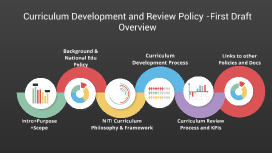good template
Transcript: Curriculum Development and Review Policy -First Draft Overview Background & National Edu Policy Curriculum Development Process Links to other Policies and Docs Curriculum Review Process and KPIs Intro+Purpose+Scope NITI Curriculum Philosophy & Framework Introduction & Purpose Introduction to Policy and its need in relevance to NITI/NPA, along with the purpose is covered in this section NITI Overview included References from “Reviews of National Policies in Saudi Arabia - Education in Saudi Arabia, OECD -2020" included The principal elements of Qualification Framework as per “NQF for Higher Education in KSA (May 2009)” included and relevancy to NITI levels shown. What NITI has been following with the development of curriculum processes and teaching practices are highlighted in order to provide a background to the policy 3 Curriculum Development process covered New CD Process Cycle 1. New Curriculum Development Presenting data Tips for presenting data Presentations with compelling visuals are 43% more persuasive than those without. 2. Adapting to accredited curriculum 1 1. Don't use two figures to represent the same number 2 Switch the format and content to keep your audience engaged Avoid back-to-back charts 2. 3 Explain what the chart says 3. Leave your visual up for a few minutes and tell a story 4 Don’t include unnecessary data Show the right amount of data 4. vs. 5 Highlight 1-2 significant key features Separate related data instead of combining datasets onto one module vs. Include visuals along with the data points Never sacrifice clarity for more information Visuals must be very clear 5. 6 Colors should be clear, contrasting, pleasing, branded, consistent Don’t make your audience work harder than they need to to understand the data Labels, titles, and legends need to be large format, easy to read, visible fonts Keep it simple - avoid unnecessary text, colors, grids, legends, etc. Maintain consistency in design and branding Explain where your data comes from - attribute, source, credibility 6. Additional design tips for data visuals 3. Utilizing existing accredited curriculum Things you should not do Truncated y-axis Use similar colors and categories Poor use of dual axis Improper sized visuals/illustrations Conclusion It only takes a little bit of time to look at the data you are presenting to plan what you’d like to say Just make sure you aren’t overwhelming your audience and are presenting your data as simply as possible You took time collecting and analyzing your data, now you can use it to make a great presentation Data storytelling You have data and a story to tell vs. vs. Sentence About 58 percent of the top brands in the world have over 100,000 Twitter followers. Data points 58 % of the top brands in the world have over 100,000 Twitter followers. Visual 58 % of the top brands in the world have over 100,000 Twitter followers. Providing context and story to data makes it more interesting and easy to understand Stories are always more relatable they make up 2/3 of our conversations Data storytelling isn’t limited to the written word The story of John and Michael Boss asks them to provide some stats about the different ethnicities living in New York. Both went to Wikipedia. John The New York City metropolitan area is home to nearly a quarter of the nation's Indian Americans and 15% of all Korean Americans and the largest Asian Indian population in the Western Hemisphere; the largest African American community of any city in the country; and including 6 Chinatowns in the city proper, comprised as of 2008 a population of 659,596 overseas Chinese, the largest outside of Asia. New York City alone, according to the 2010 Census, has now become home to more than one million Asian Americans, greater than the combined totals of San Francisco and Los Angeles. New York contains the highest total Asian population of any U.S. city proper. 6.0% of New York City is of Chinese ethnicity, with about forty percent of them living in the borough of Queens alone. Koreans make up 1.2% of the city's population, and Japanese at 0.3%. Filipinos are the largest southeast Asian ethnic group at 0.8%, followed by Vietnamese who make up only 0.2% of New York City's population. Indians are the largest South Asian group, comprising 2.4% of the city's population, and Bangladeshis and Pakistanis at 0.7% and 0.5%, respectively. Michael Ethnic communities in the New York metropolitan area It’s not just the data - it’s what the data means. Trends Contrast Outliers

















